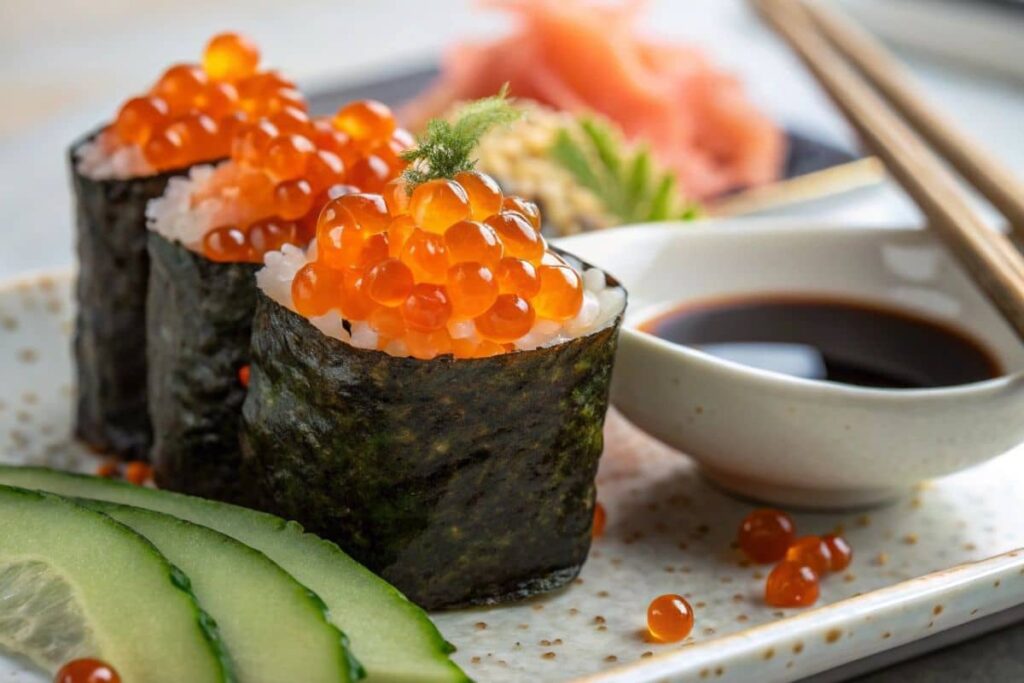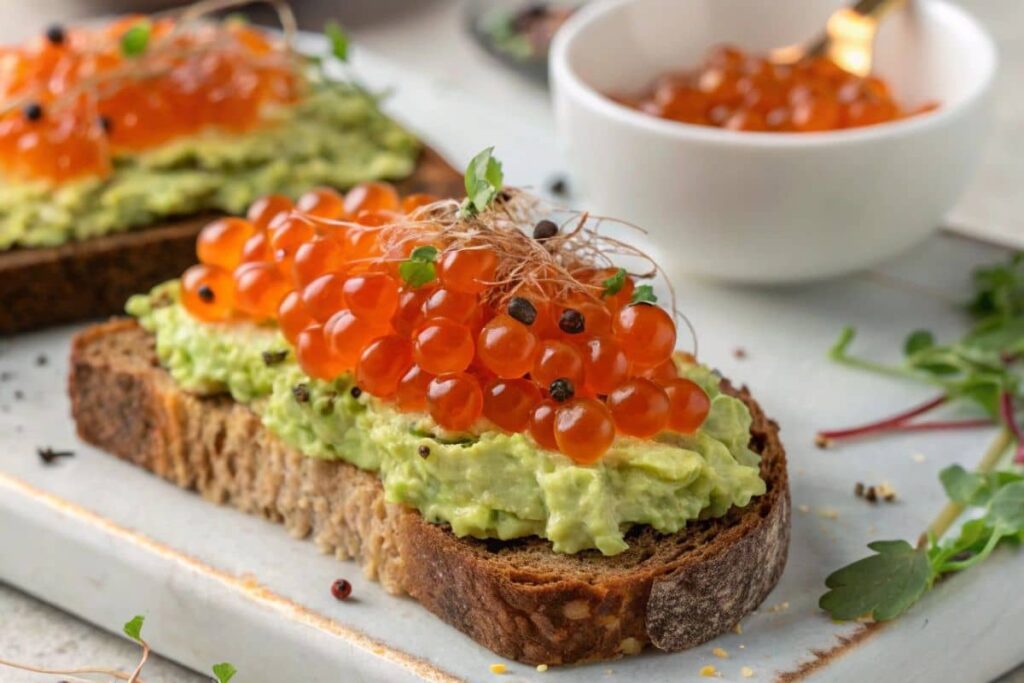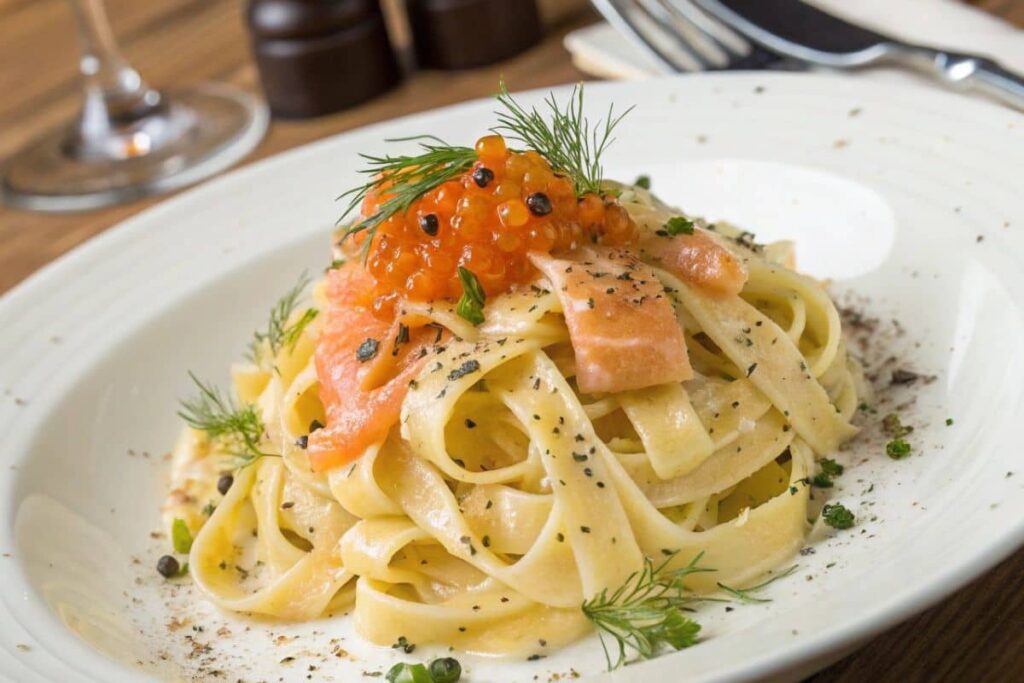Is salmon roe healthy? If you’ve ever wondered about the nutritional value of this tiny, flavorful treat, you’re not alone! Salmon roe, or ikura, has been gaining popularity due to its luxurious taste and impressive health benefits. But is it just a trendy food, or does it deserve a place in your regular diet? In this article, we’ll explore the truth behind the nutritional value of salmon roe, its health benefits, and potential concerns so you can make an informed decision about whether it’s a healthy addition to your meals.
Table of Contents

Understanding Salmon Roe: What Is It Made Of?
Before we can answer whether salmon roe is healthy, let’s take a closer look at what it’s made of. Essentially, salmon roe is the eggs from the female salmon fish, and each tiny egg is a nutrient powerhouse. These eggs are rich in protein, omega-3 fatty acids, vitamins, and minerals.
Salmon roe has been a part of many diets around the world, especially in places like Japan and Russia. But today, we’re finding it everywhere – from sushi rolls to gourmet dishes in fancy restaurants. Its rich, savory taste and nutritional benefits make it a perfect choice for anyone looking to eat more nutrient-dense foods.
The Origins of Salmon Roe: From Ocean to Plate
The journey of salmon roe begins far from your dinner table, in the cold, fresh waters where salmon thrive. These tiny eggs are harvested during the salmon’s spawning season. After being carefully collected, they are typically preserved in salt, which helps to extend their shelf life and enhances their flavor. Salmon roe is usually sold fresh, frozen, or in brine, depending on the region and its intended use.
For many, salmon roe represents the pinnacle of luxury dining, served in small, delicate portions due to its rich and intense flavor. But behind this luxury is a treasure trove of health benefits that go beyond just being a tasty treat.
Types of Salmon Roe: Differences Between Ikura and Other Varieties
When you hear the term “salmon roe,” it’s important to know that there are different types. The most commonly known type is ikura, which is often featured in sushi. But there are also other varieties, including chum and sockeye roe. Each type of roe has a slightly different flavor profile and nutritional makeup.
- Ikura (Salmon Roe): These are the large, glossy orange eggs that you usually see on sushi. They have a mild, briny flavor and a satisfying pop when you bite into them.
- Chum Roe: Smaller and more delicate, chum roe is not as commonly used in high-end dishes, but it’s still a great source of nutrition.
- Sockeye Roe: Known for its smaller, firmer texture, sockeye roe has a slightly stronger flavor compared to ikura.
All types of salmon roe are packed with similar nutrients, but the taste and texture can vary. Whether you prefer the larger eggs of ikura or the smaller eggs of sockeye, you’ll still be getting a nutrient-packed treat.
Nutritional Profile of Salmon Roe
Now let’s get into the real question: is salmon roe healthy? The answer depends on what exactly you’re looking for in your diet. But one thing is clear – salmon roe is loaded with nutrients that are beneficial for your body. Let’s break down what makes it such a nutritious food.
Protein Content: A Powerhouse for Muscle and Metabolism
One of the standout features of salmon roe is its high protein content. If you’re looking to build muscle, boost metabolism, or simply maintain a healthy body, salmon roe is a fantastic choice. Protein is essential for repairing tissues, building muscles, and supporting your immune system.
Block Quote:
“Protein is a building block for your muscles, skin, and even your hormones. With 1 tablespoon of salmon roe providing about 6 grams of protein, it’s a powerful addition to your diet!”
A small serving of salmon roe can provide around 6 grams of protein – that’s more than what you’d get from a typical egg or a small serving of chicken. So, if you’re active or just looking to maintain a balanced diet, salmon roe can give your body the protein boost it needs.
Omega-3 Fatty Acids: Heart Health Benefits
Omega-3 fatty acids are one of the main reasons why salmon roe is considered such a superfood. These essential fats are known for their heart health benefits and their ability to reduce inflammation in the body. In fact, omega-3s have been linked to a lower risk of heart disease, improved brain function, and even better skin health.
Salmon roe contains a high concentration of omega-3 fatty acids, which can help lower triglycerides, reduce blood pressure, and improve overall cardiovascular health. For anyone looking to take care of their heart, adding salmon roe to your diet might just be a tasty solution.
Vitamins and Minerals in Salmon Roe: A Nutrient-Rich Superfood
Salmon roe isn’t just about protein and omega-3s – it’s also packed with vitamins and minerals that your body needs to function at its best. Some of the key nutrients found in salmon roe include:
- Vitamin A: Helps maintain healthy vision and skin.
- Vitamin D: Supports bone health and helps your body absorb calcium.
- B Vitamins (especially B12): Essential for energy production, brain health, and red blood cell formation.
- Iron: Necessary for carrying oxygen to your cells and maintaining energy levels.
These vitamins and minerals make salmon roe a powerful, nutrient-dense food that can help support your overall well-being.
Caloric and Fat Content: Is It Worth the Calories?
Like any food, salmon roe does contain calories, and while it’s nutrient-dense, it’s also a bit high in fat. This doesn’t mean you should avoid it, but rather that you should enjoy it in moderation.
A typical serving of salmon roe (around 1 tablespoon) contains about 50-60 calories, with a significant portion coming from healthy fats. These fats are mostly omega-3 fatty acids, which, as we’ve already discussed, are great for heart health. However, if you’re watching your calorie intake or following a specific diet, you may want to keep track of how much roe you’re eating.
Block Quote:
“Salmon roe may be high in fat, but it’s the *good* kind of fat! Omega-3s are essential for heart and brain health, so don’t be afraid to indulge in moderation.”
Overall, the fat content of salmon roe is beneficial, especially considering it’s rich in healthy omega-3s. Just be mindful of your portion sizes, especially if you’re tracking calories or following a specific diet plan.
Health Benefits of Eating Salmon Roe
So, now that we know about the nutritional profile of salmon roe, let’s talk about the health benefits. Is it truly good for you? Let’s explore!
Boosting Brain Function with Omega-3 Fatty Acids
Omega-3 fatty acids, particularly those found in salmon roe, are crucial for brain health. These healthy fats contribute to improved cognitive function and memory. If you’re trying to stay sharp, eat well, and support brain health, salmon roe is a great addition to your diet.
Research has shown that omega-3s can play a role in reducing the risk of cognitive decline and can even help alleviate symptoms of depression and anxiety. So, by eating salmon roe regularly, you might just give your brain a boost!
Salmon Roe and Its Role in Reducing Inflammation
Chronic inflammation is at the root of many health issues, from joint pain to heart disease. Fortunately, salmon roe is an excellent anti-inflammatory food thanks to its high omega-3 content. Omega-3s have been shown to help reduce inflammation in the body, which can lead to better overall health and a reduced risk of diseases like arthritis and cardiovascular disease.
Eating salmon roe may help your body fight off inflammation, making it a great choice if you want to stay healthy and feel your best.
The Impact of Salmon Roe on Skin Health
Salmon roe is loaded with nutrients that support healthy skin, including omega-3 fatty acids, vitamin D, and vitamin A. These nutrients work together to promote healthy, glowing skin and help with issues like dryness, acne, and aging. If you’re looking for a food that nourishes your skin from the inside out, salmon roe might be just what you need.
A Natural Source of Vitamin D: How It Supports Bone Health
Vitamin D is essential for strong bones because it helps your body absorb calcium. While the sun is one natural source of vitamin D, salmon roe is another! Just a small serving of salmon roe can provide a significant portion of your daily vitamin D needs, making it an excellent choice for maintaining bone health, especially during the winter months when sunlight is limited.
The Risks and Concerns of Eating Salmon Roe
While salmon roe has numerous health benefits, like any food, it’s important to be aware of potential risks and concerns. In this section, we’ll take a look at the challenges you might face when consuming salmon roe and how to address them.
Potential Contaminants in Salmon Roe: What You Should Know
One concern about eating salmon roe is the potential for contamination with harmful substances like mercury, PCBs (polychlorinated biphenyls), and other toxins that can accumulate in fish. These contaminants can have negative health effects if consumed in large quantities over time.
To minimize exposure, it’s important to choose high-quality salmon roe that comes from reputable sources. Look for roe that is wild-caught, and whenever possible, choose roe that has been tested for contaminants. Many health-conscious consumers also opt for roe from sustainably farmed sources, which tend to have lower levels of contaminants.
Block Quote:
“By choosing high-quality, responsibly sourced salmon roe, you can enjoy its benefits while minimizing exposure to harmful toxins.”
High Sodium Levels in Salmon Roe: Is It Safe for Those with High Blood Pressure?
Another risk associated with salmon roe is its high sodium content. The eggs are often preserved in brine, which adds a significant amount of salt. For people with high blood pressure or those trying to reduce their sodium intake, this could be a concern.
If you have high blood pressure or are sensitive to sodium, it’s important to enjoy salmon roe in moderation. You can also look for lower-sodium versions of salmon roe, or rinse the roe before eating it to remove some of the salt. As always, balance is key!
Allergies and Sensitivities: Can Salmon Roe Trigger Reactions?
Like many other types of fish and seafood, salmon roe can trigger allergic reactions in some people. Symptoms can range from mild itching and hives to more serious reactions like difficulty breathing. If you have a known fish or seafood allergy, it’s essential to avoid salmon roe.
Even if you’re not allergic to fish, it’s a good idea to introduce salmon roe into your diet gradually. Start with small amounts to see how your body reacts before incorporating it into your regular meals.

How to Incorporate Salmon Roe Into Your Diet
Now that we’ve discussed the health benefits and risks of salmon roe, let’s talk about how you can actually include this nutritious food in your diet. Luckily, salmon roe is versatile and can be used in many different dishes. Whether you’re a sushi lover or just want to add a bit of luxury to your meals, there are plenty of ways to enjoy it!
Best Ways to Enjoy Salmon Roe: From Sushi to Gourmet Dishes
One of the most common ways to enjoy salmon roe is in sushi. Ikura is often used as a topping for nigiri sushi or as a filling in maki rolls. The pop of flavor and texture it adds to each bite makes it a favorite among sushi fans.
But sushi isn’t the only way to enjoy salmon roe. You can also serve it on top of toast or crackers for a simple yet luxurious appetizer. Pair it with a dollop of crème fraîche or sour cream, or even mix it with avocado for a tasty snack.
For a more sophisticated dish, salmon roe pairs well with other seafood like smoked salmon, scallops, or oysters. It can be used as a garnish for pasta, salads, or even soups, adding a burst of flavor and color to any dish.
Pairing Salmon Roe with Other Foods for Maximum Nutritional Benefit
To get the most out of salmon roe’s nutritional value, try pairing it with other nutrient-dense foods. For example, combine it with leafy greens like spinach or kale for a salad packed with vitamins and minerals. Or, enjoy it alongside whole grains like quinoa or brown rice for a healthy, balanced meal.
Since salmon roe is high in healthy fats, it pairs beautifully with fiber-rich vegetables, which can help with digestion and balance blood sugar levels. Combining it with foods that support digestion, like fermented foods (think kimchi or sauerkraut), can enhance the overall health benefits of your meal.
How to Choose High-Quality Salmon Roe
The quality of salmon roe can vary significantly, and choosing high-quality roe is essential if you want to maximize its health benefits. Here’s what to look for when shopping for salmon roe.
Fresh vs. Processed: Which Is Better for Your Health?
Fresh salmon roe is usually preferred over processed roe, as it contains fewer preservatives and additives. When shopping for salmon roe, check for freshness by looking at the color and texture. Fresh roe should be bright orange, translucent, and plump, while older roe may appear dull or have a mushy texture.
Processed salmon roe, which is often sold in jars or cans, can have a longer shelf life but may contain added preservatives and higher levels of sodium. If you choose processed roe, look for options with minimal added ingredients and check the label for any preservatives or artificial flavorings.
Sustainable Salmon Roe: How to Make Eco-Friendly Choices
If you’re concerned about sustainability, choose salmon roe that comes from responsibly farmed or wild-caught sources. Overfishing is a concern in many parts of the world, and choosing sustainably sourced salmon roe can help protect the environment and ensure the health of future fish populations.
Look for certifications like the Marine Stewardship Council (MSC) label or inquire about the farming practices of the roe’s source. Sustainable farming practices help reduce the environmental impact and ensure that the fish are raised in healthy, humane conditions.
Frequently Asked Questions About Salmon Roe
Now, let’s take a look at some common questions people have about salmon roe and its health benefits.
Is Salmon Roe Healthier Than Caviar?
Both salmon roe and caviar (which is typically made from sturgeon eggs) are rich in omega-3 fatty acids, protein, and other nutrients. However, salmon roe tends to be more affordable and is widely available, while caviar is considered a luxury food. In terms of health benefits, both are nutritious, but salmon roe has a higher omega-3 content and may be slightly better for heart health.
Can I Eat Salmon Roe If I’m Pregnant?
Salmon roe can be a healthy addition to your diet during pregnancy, as it’s packed with nutrients like protein, omega-3s, and vitamins. However, it’s important to ensure that the roe is from a safe, uncontaminated source. Always consult your healthcare provider before making any dietary changes during pregnancy.
How Often Should You Eat Salmon Roe?
While salmon roe is packed with nutrients, it’s also high in sodium and calories, so it’s best enjoyed in moderation. Eating salmon roe once or twice a week is a good way to reap the benefits without overdoing it. Just be sure to balance your diet with other nutrient-dense foods.

Conclusion: Is Salmon Roe a Healthy Addition to Your Diet?
Salmon roe is undoubtedly a nutrient-dense superfood, packed with protein, omega-3 fatty acids, and vitamins that support everything from brain health to bone strength. While it has some risks, such as high sodium content and potential contaminants, choosing high-quality, sustainably sourced roe can help mitigate these concerns.
So, is salmon roe healthy? The answer is a resounding yes – when consumed in moderation and as part of a balanced diet, it can offer a host of health benefits. Whether you enjoy it as part of sushi or as a gourmet topping, adding salmon roe to your meals can be a delicious and nutritious choice.
Explore More Delicious and Healthy Recipes
Salmon Roe Sushi: How to Make Salmon Roe Sushi At Home
Salmon Roe vs Caviar: Which Is Healthier?
Ikura Salmon Roe: Everything You Need to Know About This Delicacy
Salmon Roe: Health Benefits and Nutritional Insights
Purple Sweet Potato Recipe: A Delicious and Nutritious Choice






